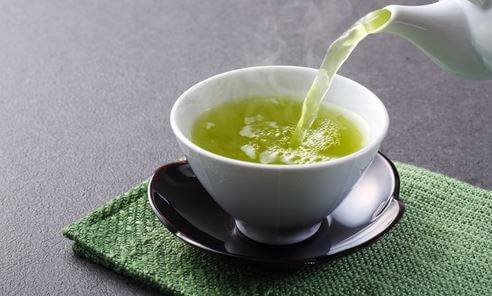Types of Teas and Their Benefits

Tea is the most popular drink in the world after water. But what do you know about the different types of teas and their benefits? Tea plants are native to areas in China, Taiwan, Japan, Sri Lanka, Nepal, Australia, and Kenya. There, tea (Camellia Sinensis) grows in bushes in mountainous regions. In this article, we’ll take a look at the six main types of teas and their benefits.
Teas and their benefits: white tea
White tea uses the youngest and most tender leaves and is of the highest quality. Once harvested, the leaves are left to wither under controlled conditions.
Benefits of white tea:
- Since it has huge amounts of antioxidants and polyphenols, it may help increase your defenses and eliminate free radicals.
- Helps fight the effects of aging on skin and may help prevent cancer.
- Since it contains fluoride, it helps protect teeth.
- Helps to combat physical and mental fatigue, boosting concentration and memory.
- Since it has less theine, it’s better for those who have issues with being nervous.
- Eliminates fat thanks to its diuretic effect and it has zero calories.
- Finally, it lowers levels of LDL cholesterol and triglycerides.
Green tea
Indeed, green tea is the best-known. It has little oxidation since the drying process and the halting of the fermentation process is performed right after harvest.

Benefits of green tea:
- Since it has huge amounts of antioxidants and polyphenols, it may help increase your defenses and eliminate free radicals.
- Helps fight the effects of aging on skin and may help prevent cancer.
- Contains vitamins A, C, E, and selenium.
- Stimulates the reduction of LDL cholesterol and increases HDL cholesterol, aka the “good” kind. Also, it fights heart disease and triglycerides.
- Prevents hypertension.
- Helps eliminate fat, has a mild diuretic effect, and stabilizes insulin.
- Helps to treat diabetes since it reduces glucose levels.
- Has an astringent effect.
- Finally, it fights the appearance of cavities due to its fluoride content.
Want to know more?: Matcha Green Tea: A Great Choice For The Body
Yellow tea
Indeed, yellow tea is the least known and comes lightly oxidized.
Benefits of yellow tea:
- Boosts concentration.
- Helps counteract the appearance of oral cavities due to its high fluoride content.
- High in antioxidants and acts as a diuretic.
- Has many minerals such as iron, phosphorus, and magnesium.
Oolong tea
Oolong tea shares the properties of green and black types of teas and their benefits. The leaves are dried for about an hour, before completing the drying process in a closed environment. This is to stop fermentation through oxidation or steaming.
Benefits of oolong tea:
- May be effective in fighting cancer due to its high concentration of tannins.
- May help to treat obesity.
- Since it has huge amounts of antioxidants and polyphenols, it may help increase your defenses and eliminate free radicals.
- Stabilizes cholesterol levels.
- Contains vitamins and minerals.
Black tea
Its black color comes from the leaves undergoing complete oxidation. As a result, its flavor is strong and intense.
Benefits of black tea
- Reduces the risk of heart attacks since it helps improve blood vessel dilation and contraction.
- Also reduces the risk of heart problems thanks to it slowing the formation of atheromatous plaque.
- Helps to prevent oral cavities thanks to its fluoride content.
- Relieves headaches that are due to fatigue.
Read more on: Five Headache Remedies
Rooibos
Rooibos offers the most health benefits. This tea is also fermented but it’s spread out to dry in the sun afterward. As a result, its production requires more time than other types of tea. It has a unique flavor and aroma, as well as its distinctive dark red color.

Thanks to its double fermentation process, rooibos tea offers many health benefits:
- helps lower weight and LDL cholesterol levels.
- Has great diuretic properties.
- May help boost your immune system.
- May help with indigestion.
- Prevents the appearance of oral cavities due to its fluoride content.
In conclusion, we hope that you’ve learned something about the many types of teas and their benefits. Make sure to try them all and decide which one you like best.
Tea is the most popular drink in the world after water. But what do you know about the different types of teas and their benefits? Tea plants are native to areas in China, Taiwan, Japan, Sri Lanka, Nepal, Australia, and Kenya. There, tea (Camellia Sinensis) grows in bushes in mountainous regions. In this article, we’ll take a look at the six main types of teas and their benefits.
Teas and their benefits: white tea
White tea uses the youngest and most tender leaves and is of the highest quality. Once harvested, the leaves are left to wither under controlled conditions.
Benefits of white tea:
- Since it has huge amounts of antioxidants and polyphenols, it may help increase your defenses and eliminate free radicals.
- Helps fight the effects of aging on skin and may help prevent cancer.
- Since it contains fluoride, it helps protect teeth.
- Helps to combat physical and mental fatigue, boosting concentration and memory.
- Since it has less theine, it’s better for those who have issues with being nervous.
- Eliminates fat thanks to its diuretic effect and it has zero calories.
- Finally, it lowers levels of LDL cholesterol and triglycerides.
Green tea
Indeed, green tea is the best-known. It has little oxidation since the drying process and the halting of the fermentation process is performed right after harvest.

Benefits of green tea:
- Since it has huge amounts of antioxidants and polyphenols, it may help increase your defenses and eliminate free radicals.
- Helps fight the effects of aging on skin and may help prevent cancer.
- Contains vitamins A, C, E, and selenium.
- Stimulates the reduction of LDL cholesterol and increases HDL cholesterol, aka the “good” kind. Also, it fights heart disease and triglycerides.
- Prevents hypertension.
- Helps eliminate fat, has a mild diuretic effect, and stabilizes insulin.
- Helps to treat diabetes since it reduces glucose levels.
- Has an astringent effect.
- Finally, it fights the appearance of cavities due to its fluoride content.
Want to know more?: Matcha Green Tea: A Great Choice For The Body
Yellow tea
Indeed, yellow tea is the least known and comes lightly oxidized.
Benefits of yellow tea:
- Boosts concentration.
- Helps counteract the appearance of oral cavities due to its high fluoride content.
- High in antioxidants and acts as a diuretic.
- Has many minerals such as iron, phosphorus, and magnesium.
Oolong tea
Oolong tea shares the properties of green and black types of teas and their benefits. The leaves are dried for about an hour, before completing the drying process in a closed environment. This is to stop fermentation through oxidation or steaming.
Benefits of oolong tea:
- May be effective in fighting cancer due to its high concentration of tannins.
- May help to treat obesity.
- Since it has huge amounts of antioxidants and polyphenols, it may help increase your defenses and eliminate free radicals.
- Stabilizes cholesterol levels.
- Contains vitamins and minerals.
Black tea
Its black color comes from the leaves undergoing complete oxidation. As a result, its flavor is strong and intense.
Benefits of black tea
- Reduces the risk of heart attacks since it helps improve blood vessel dilation and contraction.
- Also reduces the risk of heart problems thanks to it slowing the formation of atheromatous plaque.
- Helps to prevent oral cavities thanks to its fluoride content.
- Relieves headaches that are due to fatigue.
Read more on: Five Headache Remedies
Rooibos
Rooibos offers the most health benefits. This tea is also fermented but it’s spread out to dry in the sun afterward. As a result, its production requires more time than other types of tea. It has a unique flavor and aroma, as well as its distinctive dark red color.

Thanks to its double fermentation process, rooibos tea offers many health benefits:
- helps lower weight and LDL cholesterol levels.
- Has great diuretic properties.
- May help boost your immune system.
- May help with indigestion.
- Prevents the appearance of oral cavities due to its fluoride content.
In conclusion, we hope that you’ve learned something about the many types of teas and their benefits. Make sure to try them all and decide which one you like best.
All cited sources were thoroughly reviewed by our team to ensure their quality, reliability, currency, and validity. The bibliography of this article was considered reliable and of academic or scientific accuracy.
- T. R., D., G, T., N.F, T., M.G., A., P.F., O., & B. M., S. (2013). White Tea (Camellia Sinensis (L.): Antioxidant Properties and Beneficial Health Effects. International Journal of Food Science, Nutrition and Dietetics. https://doi.org/10.19070/2326-3350-130005
- Almajano, M. P., Vila, I., & Gines, S. (2011). Neuroprotective Effects of White Tea Against Oxidative Stress-Induced Toxicity in Striatal Cells. Neurotoxicity Research. https://doi.org/10.1007/s12640-011-9252-0
- Hajiaghaalipour, F., Kanthimathi, M. S., Sanusi, J., & Rajarajeswaran, J. (2015). White Tea (Camellia sinensis) Inhibits Proliferation of the Colon Cancer Cell Line, HT-29, Activates Caspases and Protects DNA of Normal Cells Against Oxidative Damage. Food Chemistry. https://doi.org/10.1016/j.foodchem.2014.07.005
- Li, S., Lo, C. Y., Pan, M. H., Lai, C. S., & Ho, C. T. (2013). Black tea: Chemical analysis and stability. Food and Function. https://doi.org/10.1039/c2fo30093a
- Vanka, A., & Vanka, S. (2012). White Tea: A Contributor to Oral Health. Dental research journal, 9(4), 504.
- Cabrera, C., Artacho, R., & Giménez, R. (2006). Beneficial Effects of Green Tea—A Review. Journal of the American College of Nutrition. https://doi.org/10.1080/07315724.2006.10719518
- Boehm, K., Borrelli, F., Ernst, E., Habacher, G., Hung, S. K., Milazzo, S., & Horneber, M. (2009). Green tea (Camellia sinensis) for the prevention of cancer. Cochrane Database of Systematic Reviews. https://doi.org/10.1002/14651858.CD005004.pub2
- Cheng, T. O. (2006). All Teas Are Not Created Equal: The Chinese green tea and cardiovascular health. International Journal of Cardiology. https://doi.org/10.1016/j.ijcard.2005.05.038
- Yang, Y. C., Lu, F. H., Wu, J. S., Wu, C. H., & Chang, C. J. (2004). The protective effect of habitual tea consumption on hypertension. Archives of Internal Medicine. https://doi.org/10.1001/archinte.164.14.1534
- Anderson, R. A., & Polansky, M. M. (2002). Tea enhances insulin activity. Journal of Agricultural and Food Chemistry. https://doi.org/10.1021/jf020514c
- Marnewick, J. L., Rautenbach, F., Venter, I., Neethling, H., Blackhurst, D. M., Wolmarans, P., & MacHaria, M. (2011). Effects of rooibos (Aspalathus linearis) on oxidative stress and biochemical parameters in adults at risk for cardiovascular disease. Journal of Ethnopharmacology. https://doi.org/10.1016/j.jep.2010.08.061
This text is provided for informational purposes only and does not replace consultation with a professional. If in doubt, consult your specialist.








